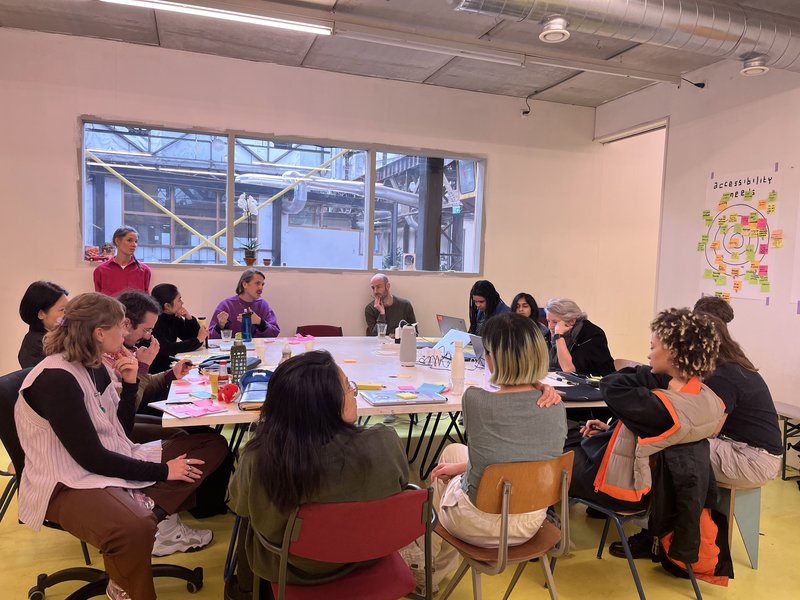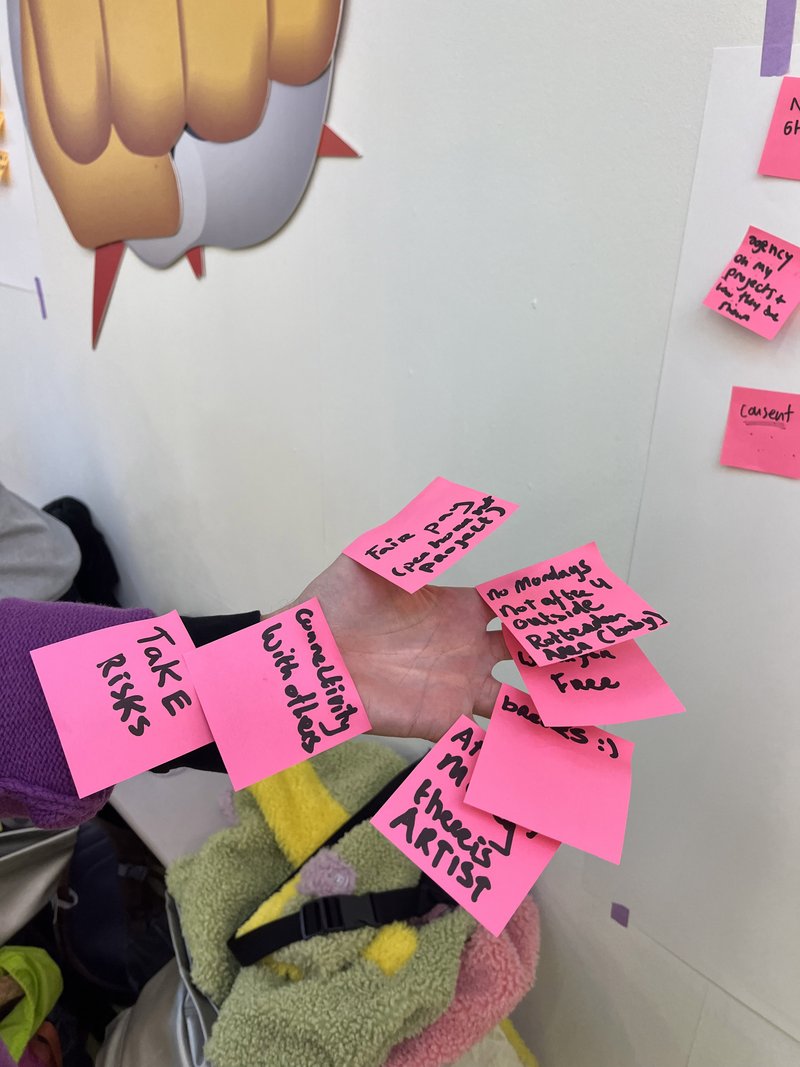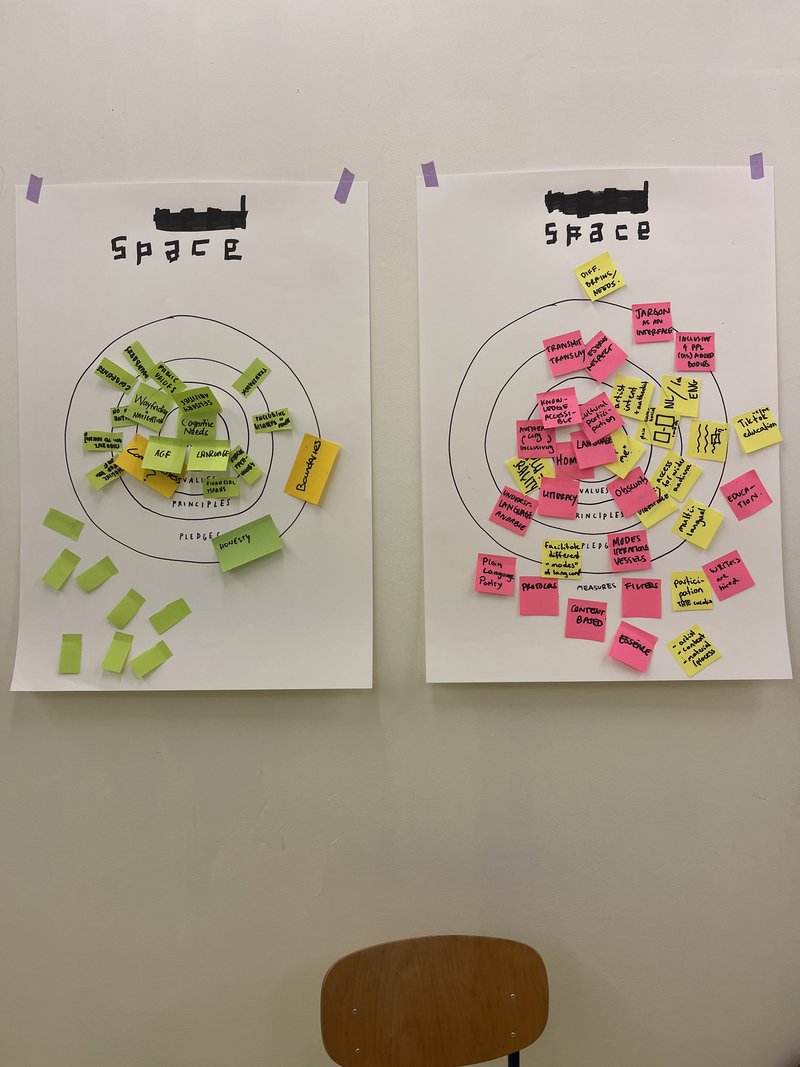report
Accessibility and Inclusion
Participants
The particiants, each hailing from diverse backgrounds in creative and design fields, share an interest for innovation and pushing boundaries. Whether exploring digital art, technology-driven design, or speculative futures, they collectively strive to break new ground. Additionally, a commitment to interdisciplinary collaboration underscores their ethos, as many bridge art with technology, anthropology with design, or AI with creative practice.
Florian: artist and designer within digital culture - moderation, hosting, designing, and so on
Victor: creative studio, design tech
Jonas: experience design studio in rotterdam - “Phygital Interfaces” - working with public institutions
Sand: designer, video, 4D, game design
Soyun: Rgbdog Studio, artist and designer
Quon: creative technologist and researcher, UvA, AI
Nadia: AIxDesign, global community on critical AI practices
Karl: digital designer, working with H&D
Yu: artist/designer
Bianca: 3D landscapes, speculate futures, designer and artist
Anania: indian/eindhoven based artist and designer
Alice: antropology
Lea: designer of hybrid spaces
Nika: visual and performance designer and artist
Martijn: artist, early computer art
The session was orchestrated and conceptualized by Angelique from Affect Lab, along with Lilian, Carolina, and Margot from The Hmm, joined by Harm from MU, and Rogier facilitating mappings. Alicia, a heritage professional, delivered a compelling presentation during the event.
After the presentation round, Lilian introduces the session and does a quick recap of last session about Utopia and Dystopia.
https://going-hybrid.gutenberg.club/w/the-hmm::Voices_of_Makers::Between_Utopia_and_Dystopia.md
Alicia Hoorst
As a heritage professional with extensive experience in museums and cultural/heritage institutions, Alicia reflects on the accessibilityimportance of making collective heritage accessible, drawing from examples like the Van Gogh Museum, where accessibility means accessibilityacknowledging the shared memory of Dutch people and owning a collective heritage.
Alicia introduces a critical definition of “disabilities,” emphasizing the quoteimpact of design on diverse needs, considering factors such as the increasing numbers of people with disabilities and age-related disabilities, which can be permanent, temporary, or situational. Accessibility entails accessibilitybreaking the cycle of inaccessibility by making information, activities, and environments sensible, meaningful, and usable. It involves solutionincluding people with disabilities in every step of the process, fostering independence, and solutiontaking responsibility rather than assuming what it's like to have a disability. quoteDesign should cater to specific needs.
An example of accessibility in museums is inclusionthe use of AI to provide image descriptions, allowing visually impaired individuals to access collection objects efficiently at the Rijksmuseum. However, challengeAI implementation requires continual refinement, may not always consider intersectional perspectives, and can reflect biases inherent in the predominantly white data it is trained on, influenced by human decisions. Conversely, the Van Gogh multimedia tour presents challenges with its challengedifficult interface and heavy touch screen, indicating a need for solutionmore thoughtful testing and design considerations. Meanwhile, the Van Abbe Museum demonstrates a commitment to inclusivity and accessibility by implementing inclusionfuture-focused solutions, such as a downstairs monitor for visitors unable to use stairs.
Q&A
During the Q&A session, Karl discussed his approach to managing budgets creatively, highlighting the challenge of challengeknowledge retention within specific individuals rather than integrating it into the overall working process. Regarding the concept of delinking collections, Alicia who is partially sighted, underscores the challenge of accessibilitytranslating colors into textures, a process that can vary significantly based on the specific hues involved.
Jonas inquired about effective methods for engaging with the disability community during research and conducting initiatives. One approach is to solutiondirectly communicate with individuals within the disability community, either through challengepersonal interactions or by solutionfollowing disabled individuals online to gain insights into their experiences and perspectives. solutionBuilding networks within established disability organizations andsolutionattending events tailored for accessibility, such as museum evenings designed for those with light sensitivity, can also facilitate meaningful connections and collaborations with the disability community.
Leah asked Alicia, “questionWhere have you felt most and least cared for in terms of accessibility?” Alicia shared her experiences, noting that opinionshe felt least accommodated at the Eye Museum initially, but later was photographed and shown. On the other hand, opinionAlicia felt most accommodated at the ZieZo Beurs conference. She argues that quotethe concept of being accommodating is also reflected in one's mindset.

The group mapping and discussing
Accessibility needs
During our session, we reviewed several examples of accessibility considerations within different platforms. First, we examined NPO Start, focusing on features like the “tab” feature, language choices, and the overall framework of web development aimed at accessibility. Specific features discussed included a inclusioncontrast toggle for quiet or dark modes to accommodate users with color blindness and accessibilitylanguage adjustments to avoid using buzzwords (e.g., plus, start, max) that may be unclear to users. Additionally, we looked at issues with medium migration or integration, particularly in challengecombining television with website content, which led to an unclear identity and an overwhelming sense of clutter on the platform’s design choices. Next, we analyzed LI-MA, noting that itsinteresting-practiceorganization by last name alphabetically required users to know precisely what they were searching for, rather than allowing for serendipitous discovery. We also discussed the platformsneed for improved image descriptions to make images more informative rather than merely decorative. These examples highlighted the accessibilityimportance of thoughtful design choices and user-centered approaches in creating accessible digital experiences.
Collective mapping
Mapping together various considerations for inclusive design involves a holistic approach encompassing language use, navigation options catering to diverse preferences (e.g., search bars vs. tab and menus), considerations for accessibilitylow data accessibility, and inclusionbreaking down disciplinary boundaries to foster a more open platform. The discussion extends to the balance between anonymous participation and personalized features, exploring hybridity beyond traditional digital frameworks, and addressing diverse accessibility needs, including challengefinancial and cognitive aspects. The financial and cognitive aspects of design can sometimes pose challenges. For example, while using low-resolution images to cater to users with slower internet connections is beneficial for financial accessibility, it can inadvertently exclude visually impaired individuals who rely on clearer, more detailed images for accessibility purposes. An illustrative example is Martijn’s anecdote about his elderly mother navigating various types of media, highlighting the challenges posed by cognitive accessibility issues. This highlights the need to solutioncarefully balance different accessibility needs and find inclusive solutions that benefit a diverse range of users.
The conversation prompts ideas on platformsadaptable platforms that can solutioncustomize content based on individual needs without being overly restrictive like AI-driven solutions that can sometimes stereotype specific needs. Ultimately, the goal is to enhance user experience and foster inclusivity, drawing inspiration from platforms like platformsHet Hem that prioritize user customization and responsive design.

Gathering thoughts
After this engaging first part of the session, we had lunch and resumed with the screening of the short film “Unforgetting as Caring” by MELT. This video work creatively reconstructs archival artifacts from disability and trans technoscience histories using everyday materials. It explores the complexities of challengereaching back in time to rediscover resonant experiences and expressions, some of which may be challenging to confront.
video: https://www.youtube.com/watch?v=zcWKcOHgVKU
Mapping in small groups
We conducted an ethical solar system mapping session in small groups.


Group maps hanging up while we discussed
Group 1
In the group discussion led by Alice, participants delved into the fundamental value of care within digital spaces. They questioned questionhow we can best demonstrate care and who requires the most attention in specific contexts. Their focus centered on advocating for the underrepresented by identifying and addressing questionwhat is missing in the digital realm. They debated the necessity of solutioncreating shared spaces to fill these gaps rather than seeking to solve every issue with a single massive platform.
Group 2
Martijn’s group concentrated on identifying and addressing wayfinding and cognitive needs within digital platforms. They recognized that individuals visiting such platforms often have platformsspecific goals in mind, underscoring the reflectionimportance of designing public technology with a user-centric approach. This discussion underscored theaccessibilitysignificance of transparency in translating diverse content into accessible media, emphasizing the need tochallengeset boundaries and recognize our limitations. The group highlighted examples of successful integration of physical and digital spaces, drawing on inclusioncultural spaces in Belgium where a tread goes through the space as illustrative case studies.
Group 3
Jonas’s group explored accessibilityenhancing accessibility through language, emphasizing the role of poetry and user-friendly design in artistic expression. They discussed the challenges posed by challengecomplex and personalized artistic practices(i.e., very personal, constructed and hard to follow), advocating for solutiondifferent entry points and viewing language as a versatile tool for inclusivity. The conversation highlighted the need to platformsbalance simplicity and complexity, embracing plurality and enabling users to switch between modes seamlessly. The group questioned questionwho should take the lead in implementing these approaches.
Group 4
Victor and Florian’s group tackled cognitive accessibility and language considerations, stressing the importance of platformsensuring that digital spaces do not replace physical ones (and the other way around). They drew inspiration from interesting-practiceopen-source technologies and the strong communities backing them. The discussion raised questions about the questiongovernment's role in these initiatives and cautioned opinionagainst reinventing the wheel, pointing to research and examples like the backlash against certain technologies during the COVID-19 pandemic such as the app dedicated to the COVID pass. They agreed on the opinionimportance of equitable compensation for those involved in research and development efforts.